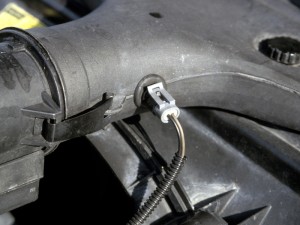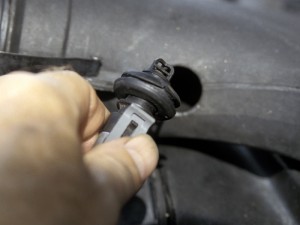Time: 60 Minutes
Tools: Drill and wiring tools
Talent: (2)
Applicable Years: 1985 to 2000
Tab: $45.00 to $50.00
Tip: A really easy modification.
Performance Gain: Very slight Increase in power, but it’s a very inexpensive and easy modification.
Complementary Work: This is a good time to install an aftermarket air foil in the throttle body.
This really easy project will give you a slight gain in performance. It may be so slight that you won’t even feel anything. On the other hand, you won’t be spending a lot of money either. The basic idea is to get an accurate reading of the air entering the intake plenum.
The Manifold Air Temperature (MAT) sensor is responsible for sending air temperature information to the ECM. It’s located directly underneath the intake plenum. Due to this location the sensor picks up engine heat and the air temp readings are incorrect, or at the least “not optimal.”
A sensor relocation kit (available for 1985-1991 (PN 304292) and 1992-2000 (PN 304710)) moves the MAT sensor to a cold air duct where the air temp is correct (cooler) and drivability is improved. The kits sold for this task relocate the sensor to the area just behind the air filter.
High air inlet temperature can lead to a change in the detonation characteristics of a given fuel mixture. This is because the computer monitors the air inlet temp and modifies the recommended ignition advance accordingly. Thus, when the inlet air temperature is measured at a given level the computer retards the ignition timing.
GM located the MAT sensor in the intake plenum because they believed that an engine should be a complete assembly when it left the production facility. There are many sound reasons that support this approach; checking system integrity and reducing installation time at the vehicle assembly plant to name but two. The location they chose made perfect sense at the time your Corvette was built.
Since you no longer need to pay attention to those same considerations you can now pick a better location to pick up the intake air temp. You want a location that’s insulated from the heat of the engine, yet is still in the inlet air flow. This is why the relocation of the MAT sensor to the filter housing makes a lot of sense. Now the sensor is measuring inlet air before it becomes heated. This means that the ignition won’t be retarded quite so often.
All you need to do is drill a 7/8” hole in the area around the air filter. Then install the rubber grommet in the housing. Next attach the new wiring harness and push the sensor through the rubber grommet. It’s that simple.
You’ll get slightly more power and better throttle response. Because the air in the filter housing is forty to fifty degrees cooler than in the intake the engine will think it’s running cold all the time and won’t be so eager to retard the timing.
Most modern engine management systems engines are now calibrated very close to the detonation limit of the fuel. On the other hand most of the C4 Corvettes were calibrated very conservatively and they can tolerate ignition advance under most circumstances, especially if you run premium gasoline. This is one of those few items where there’s really no downside, except the $50.00 price. You might even be able to feel a slight difference in performance.
 CC-3-1: This is a case where the aftermarket has the correct solution. When you place the intake air temperature sensor in the intake tube behind the air filter you’ll get a much more accurate reading of the temperature. Chevrolet couldn’t do it this way because of manufacturing problems, and thought the horsepower gain, or lower tailpipe emissions, were not significant enough to merit any changes in the manufacturing process. It’s a really easy project to do on a Saturday morning and it costs less than $50.00.
CC-3-1: This is a case where the aftermarket has the correct solution. When you place the intake air temperature sensor in the intake tube behind the air filter you’ll get a much more accurate reading of the temperature. Chevrolet couldn’t do it this way because of manufacturing problems, and thought the horsepower gain, or lower tailpipe emissions, were not significant enough to merit any changes in the manufacturing process. It’s a really easy project to do on a Saturday morning and it costs less than $50.00.
 CC-3-2: This thermistor actually measures the temperature. Before you plug it into it’s new home it wouldn’t be a bad idea to spray it down with your air intake cleaner. Just don’t try to scrub it or polish it. Actually I know some Corvette owners that might try to wax it, but that’s a story for another article.
CC-3-2: This thermistor actually measures the temperature. Before you plug it into it’s new home it wouldn’t be a bad idea to spray it down with your air intake cleaner. Just don’t try to scrub it or polish it. Actually I know some Corvette owners that might try to wax it, but that’s a story for another article.
This is an adaptation from Richard Newton’s most recent book 101 Projects for Your Corvette 1984 – 1996. He has also written two other best selling Corvette One deals with the 1968 to 1982 Corvettes, How to Restore and Modify Your Corvette 1968-82 , while another deals with the Sting Rays from 1963 to 1967, Corvette Restoration Guide 1963-1967. All of these books are available from Corvette Central.
I have and 85 C4 I wanted to try this on but unfortunately I am in CA so it looks like this upgrade is a non-starter. Anyone have advice on this IAT relocation topic?
I tried this mod on my 1986 C4 recently. It tripped a “Service Engine Soon” lamp as soon as the car reached operating temp. I tried resetting the ECM but no effect. I ended up having to return the IAT to it’s factory position under the plenum (a real PITA!). As soon as I did that, no more SES lamp. Just an fyi – the idle did improve some with the relocation but the SES lamp was too annoying to ignore. Plus in CA, you won’t pass smog test with an SES lamp glowing